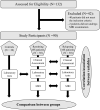Tissue factor as a potential coagulative/vascular marker in relapsing-remitting multiple sclerosis
- PMID: 37583699
- PMCID: PMC10424925
- DOI: 10.3389/fimmu.2023.1226616
Tissue factor as a potential coagulative/vascular marker in relapsing-remitting multiple sclerosis
Abstract
Objectives: Recent studies supported coagulation involvement in multiple sclerosis, an inflammatory-demyelinating and degenerative disease of the central nervous system. The main objectives of this observational study were to identify the most specific pro-coagulative/vascular factors for multiple sclerosis pathogenesis and to correlate them with brain hemodynamic abnormalities.
Methods: We compared i) serum/plasma levels of complement(C)/coagulation/vascular factors, viral/microbiological assays, fat-soluble vitamins and lymphocyte count among people with multiple sclerosis sampled in a clinical remission (n=30; 23F/7M, 40 ± 8.14 years) or a relapse (n=30; 24F/6M, age 41 ± 10.74 years) and age/sex-matched controls (n=30; 23F/7M, 40 ± 8.38 years); ii) brain hemodynamic metrics at dynamic susceptibility contrast-enhanced 3T-MRI during relapse and remission, and iii) laboratory data with MRI perfusion metrics and clinical features of people with multiple sclerosis. Two models by Partial Least Squares Discriminant Analysis were performed using two groups as input: (1) multiple sclerosis vs. controls, and (2) relapsing vs. remitting multiple sclerosis.
Results: Compared to controls, multiple sclerosis patients had a higher Body-Mass-Index, Protein-C and activated-C9; and a lower activated-C4. Levels of Tissue-Factor, Tie-2 and P-Selectin/CD62P were lower in relapse compared to remission and HC, whereas Angiopoietin-I was higher in relapsing vs. remitting multiple sclerosis. A lower number of total lymphocytes was found in relapsing multiple sclerosis vs. remitting multiple sclerosis and controls. Cerebral-Blood-Volume was lower in normal-appearing white matter and left caudatum while Cerebral-Blood-Flow was inferior in bilateral putamen in relapsing versus remitting multiple sclerosis. The mean-transit-time of gadolinium-enhancing lesions negatively correlated with Tissue-Factor. The top-5 discriminating variables for model (1) were: EBV-EBNA-1 IgG, Body-Mass-Index, Protein-C, activated-C4 and Tissue-Factor whereas for model (2) were: Tissue-Factor, Angiopoietin-I, MCHC, Vitamin A and T-CD3.
Conclusion: Tissue-factor was one of the top-5 variables in the models discriminating either multiple sclerosis from controls or multiple sclerosis relapse from remission and correlated with mean-transit-time of gadolinium-enhancing lesions. Tissue-factor appears a promising pro-coagulative/vascular biomarker and a possible therapeutic target in relapsing-remitting multiple sclerosis.
Clinical trial registration: ClinicalTrials.gov, identifier NCT04380220.
Keywords: biomarker; coagulation; multiple sclerosis; relapse; tissue factor.
Copyright © 2023 Koudriavtseva, Lorenzano, Cellerino, Truglio, Fiorelli, Lapucci, D’Agosto, Conti, Stefanile, Zannino, Filippi, Cortese, Piantadosi, Maschio, Maialetti, Galiè, Salvetti and Inglese.
Conflict of interest statement
TK: received grant from Italian Ministry of Health. MC: received consulting fees from Zambon, support for attending meetings/travel from Janssen. MF: received part of grant from Italian Ministry of Health. MM: received honoraria for presentation/manuscript writing and support for attending meetings/travel from EISAI. MS: received grant from FISM; speaking honoraria from Merck, Sanofi, Novartis, Roche, Viatris, Biogen, BMS; support for patents IT 1417523 and EP2981625. MI: received consulting fees from Biogen, Novartis Merck, Sanofi, Roche, BMS, Janssen; received honoraria for presentation from Biogen, Novartis Merck, Sanofi, Roche, BMS, Janssen. The remaining authors declare that the research was conducted in the absence of any commercial or financial relationships that could be construed as a potential conflict of interest.
Figures



Comment in
-
Commentary: Tissue factor as a potential coagulative/vascular marker in relapsing-remitting multiple sclerosis.Front Immunol. 2023 Dec 1;14:1320179. doi: 10.3389/fimmu.2023.1320179. eCollection 2023. Front Immunol. 2023. PMID: 38106419 Free PMC article. No abstract available.
References
Publication types
MeSH terms
Substances
Associated data
LinkOut - more resources
Full Text Sources
Medical
Research Materials
Miscellaneous

